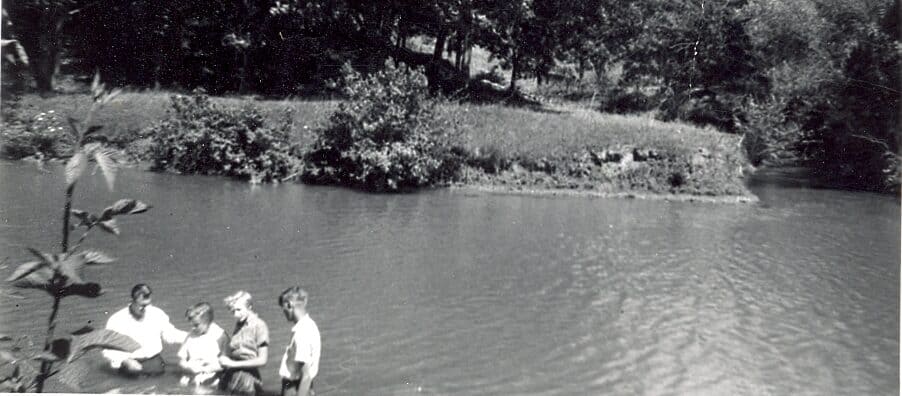Little River Place-based Interviews
Floyd County Traditions, our legacy, place-based oral history series, continued in 2002 with interviews centered around life on and along the Little River in Floyd County, Virginia. Teams of Radford University student interviewers traveled to the homes and farms of fifteen interviewees to collect a trove of audio interviews.

The Little River Series was directed by the Old Church Gallery’s Floyd Story Center in a community-university partnership with Radford University anthropology professor Dr. Melinda Bollar Wagner and her students. The series recorded the stories, family histories, and experiences of various aspects of life along the Little River in Floyd County. The student interview teams photographed the farms, homes, and Little River locations they visited. Sincere thanks to all for sharing their stories. Pictured here is a 1959 baptism on the Little River.
Below is a list of the people interviewed. Click on any of the highlighted names to read more about that particular interview:
- David Allen (2002)
- Iva Bower (2002)
- James Coartney (2002)
- Katherine Delauney (2002)
- Carl & Mae Dobbins (2002)
- George & Bettie Edwards (2002)
- Angie Gallimore; Dale Gallimore (2002)
- Leslie & Cornelia Gallimore (2002)
- Silvie Granatelli (2002)
- Gertrude Harris; Jessie Skeen (2002)
- Jack Lawson (2002)
- Cindy Maxwell (2002)
- Wade & Mary Poff (2002)
- Cobern Quesenberry (2002)
- Garfield & Velma Radford (2002)
- Margie & Roger Shortt (2002)
- Dorsey & Louise Thompson (2002)
- Terry Thompson (2002)
- Annie Ruth Wood (2002)
- Rob Yard (2002)

2002 Little River, RU Student Interview Teams
Radford University Anthropology 411 Appalachian Cultures class with Melinda Bollar Wagner, Ph.D., Professor; and Maple R. Potts, Research Assistant; and students Kathryn Ballard, Melissa Bellows, Matt Burgess, Jennifer Cline, Lindsay Coada, Ashley Crabtree, Nicole Danhauser, Dixine Darist, Christine England, Rosalynn Good, Rachel Greene, Joseph Gregory, Jessica Hamby, Megan Holzbauer, Holly Hyler, David Jones, Robert Ketner, Anna Klick, Ivan Levin, Jennifer Neel, Amy Phillips, Ashley Robbins, Kelly Schwenk, Tiffany Shifflett, Beth Smit, Tammy Stiles, Steven Storer, and Emily Talbot
Thank you all!

Floyd County’s unofficial motto is “One stoplight, no railroads, and all the water flows out,” including the Little River, which begins near the Head of the River Primitive Baptist Church (Salem Church) Copper Hill. The two forks of the river meander round-about routes through much of the county, joining as an eventual tributary to the New River, the Kanawha, the Ohio, and on to the Mississippi. In 2002, Dr. Melinda Bollar Wagner’s Radford University Anthropology 411 Appalachian Cultures class interviewed residents who lived near the Little River. Along with The Floyd Story Center at the Old Church Gallery, where the complete archive resides, the New River Land Trust partnered with the class and received a summary report.
Interviewees told of riverside gatherings and wildlife sightings and recalled gigging for frogs and fishing, observing that marine life was once more plentiful and diverse. They described past floods but noted shallower river depths now, with ice cover less frequent and thinner. The river once provided ice harvests, with ice thick enough to hold the weight of a car. Asked about the future of the river, interviewees mentioned pollution and development as concerns.

In 2003, the Anthropology 493 Practicum in Anthropology class – Kathryn Ballard, Holly Hyler, Anna Klick, Jennifer Neel, and Tiffany Shifflett – developed a multi-media presentation for the Appalachian Studies Association Conference at Eastern Kentucky University in Richmond, Kentucky, March 28-30, 2003, “The Little River Talks Back: University-Community Study of Environment and Culture in the Little River Watershed.”

